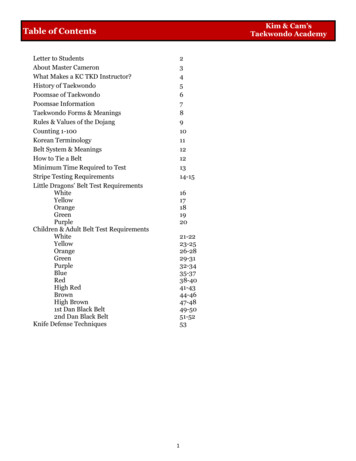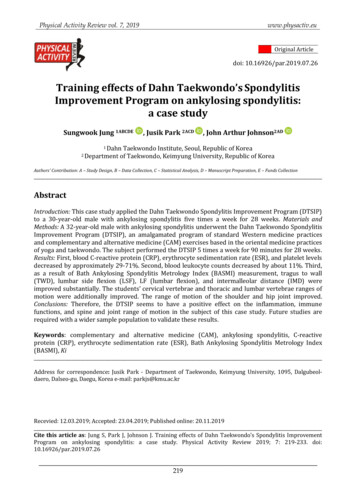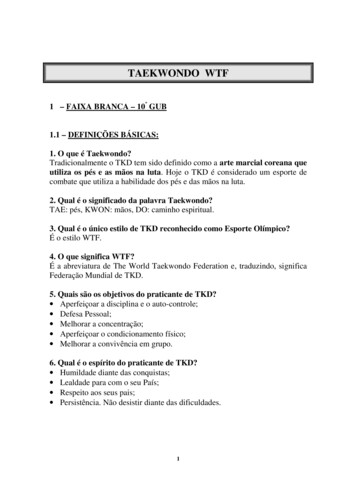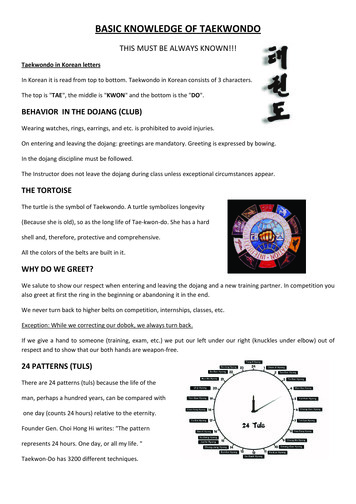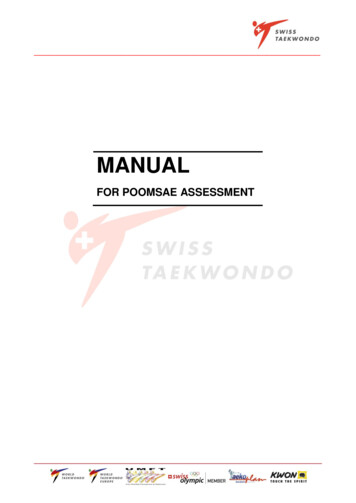
Transcription
MANUALFOR POOMSAE ASSESSMENT
Contents1. Poomsae Assessment1.1. Mark for Technique.31.1.1. Explanation of Mark for Technique.31.1.2. Technique Assessment.41.2. Mark for Presentation.61.2.1. Explanation of Mark for Presentation.62. Information Sheets.9A. Score Sheet.9B. Field of Play.10C. Kihap & Stomps.11D. Movements 5 / 8 Seconds.11E. Field Coordinator Hand Signals.12
1. Marking a PoomsaeA Poomsae assessment mark consists of a mark for technique and a mark for presentation andcan be a maximum of 10.0 points. The maximum number of points for the technique mark is 4.0,and the maximum for the presentation mark is 6.0.The Poomsae is evaluated according to a negative grading system: the competitor has a total of10.0 points before beginning the Poomsae (4.0 for technique and 6.0 for presentation). Points arededucted for errors or faults.1.1 Mark for TechniqueTechnique can be given a maximum of 4.0 points, and consists of 3 factors:1. Accuracy of Basic Movements2. Balance3. Accuracy of Details of each Poomsae1.1.1 Explanation of Mark for TechniqueThe explanations in headings 1.-3. refer to the guidelines in the “Kukkiwon Textbook” and “TheExplanation of Official Taekwondo Poomsae”, as well as the practical application within Poomsaecompetitions.1. Accuracy of basic movements- Sequence of movementso The techniques of each Poomsae must be performed in the exact sequencespecified Moving in the correct direction Starting and finishing in the same place (exceptions: Poomsae 10, 14)- Correct techniqueso Accuracy of the movements / movement coordinationo Executing the sequence of movements without errors2. Balance- Precise execution of stances and techniqueso No wobbling or signs of uncertainty- General balanceo Certainty and stability Smooth and calm (particularly for one-legged stances) No retrospective correctionso Upper body position No leaning back
3. Accuracy of details of each Poomsae- Stance / positionso Length of step exacto Different stances distinguishableo No slidingo No retrospective corrections- Execution of a hand techniqueo Precise and clearo Complete from start to finisho Technique visually distinguishableo Correct and clearly recognisable height of offensive techniques (low-section, midsection, high-section)o Offensive techniques start from the inside, defensive techniques start from the outside- Execution of a foot techniqueo Foot techniques at the defined and required heighto Clear snap at the end of the technique (power at the end of the technique)- Kihapo At least 1x in every Poomsaeo At the right time1.1.2 Technique AssessmentIn a Poomsae competition, the Poomsae is evaluated according to a negative grading system. Thecompetitor has a total of 4.0 points before starting their Poomsae. Either 0.1 or 0.3 points arededucted for each error. The technique mark cannot be negative.Deduction of 0.1 pointsEvery small deviation from the correct techniques (stances, hand and foot techniques) according to“The Explanation of Official Taekwondo Poomsae II” leads to a deduction of 0.1 points for thetechnique mark.Illustrative examples:-Raising the heel for ap / dollyo / yop chagiUncontrolled hand movement at the beltTurning and making stances on the heelsNot holding both hands in front of the body for ap chagi
Deduction of 0.3 pointsEvery serious deviation from the correct techniques (stances, hand and foot techniques) accordingto “The Explanation of Official Taekwondo Poomsae II” leads to a deduction of 0.3 points for thetechnique mark.Illustrative examples:-----Incorrect techniques / mistakes in the Poomsaeo Performing olgul makki instead of arae makkio Performing dwit kubi instead of ap kubiKihap and breathingo No kihapo Kihap in the wrong placeo Loud breathing sounds from the competitor during the PoomsaeSequence of movementso Temporary stop ( 3 seconds) during the Poomsae (competitor forgot the nextmovement)o End position is not the same as the start position (except for Poomsae 10, 14)o Leaving the competition areao Poomsae lasts less than 30 secondso Poomsae lasts more than 90 secondsNot looking in the direction of motion, the attack or the blocko Clear turn of the head and looking left when punchingo Looking backwards when performing yop chagiComplete loss of balancePutting down second foot when performing haktari sogi1.2 Mark for PresentationPresentation can be given a maximum of 6.0 points, and consists of 3 factors:1. Speed & Power (max. 2.0 points)2. Strength/Speed/Rhythm (max. 2.0 points)3. Expression of Energy (max. 2.0 points)1.2.1 Explanation of Mark for PresentationIn contrast to the technique mark, points are not deducted from the presentation mark for small orserious mistakes during the Poomsae. Instead, points are deducted on the basis of weaknesses inthe overall performance of the Poomsae in parts 1.-3. of the mark. The “key points” for the respectivePoomsae may be very helpful for the assessment.
1. Speed & Power (max. 2 points)A maximum of 2.0 points can be given out for this part of the mark. The harmony of the techniquescarried out is assessed here in terms of speed, power and balance. The focus of the assessmenthere is the interplay between the soft start, continuous acceleration, and a hard end without anyshaking at the end of a technique that critically influences the aesthetic of the Poomsae.The following points are assessed:-Do the techniques performed match the defined attributes of the techniques in the Poomsae?Are the techniques performed at the defined speed?Do the techniques performed have a soft, untensed start and a hard, powerful end?Are the techniques performed fast, powerful, explosive?Do the techniques performed have maximum power at the end?For slow techniques (5-8 seconds): are the performed techniques powerful and graceful?Specific characteristics of a Poomsae performance leading to points deductions:Too much power is used at the start of the technique, so maximum acceleration cannot beachieved.-Points should be deducted if the energy from a technique is used to strengthen the followingtechnique2. Strength/Speed/Rhythm (max. 2 points)A maximum of 2.0 points can be given out for this part of the mark. The harmonisation of the rhythm,speed and power at the end of the techniques performed are all assessed. In comparison with pointa. (Speed & Power), the focus of the assessment here is on the way in which the techniques are puttogether. The following points are assessed:-Do the individual techniques flow, and is there any hesitation?Is the start of every technique performed soft and the end hard?Is the rhythm even and error-free?Is the transition from one technique to another smooth?Do the speed, strength, and rhythm stay at a constant level?Specific characteristics of a Poomsae performance leading to points deductions:-Muscle tension too high at the start of a technique (“cramp”) resulting in no harmoniousrhythmStiffening of the (upper) bodyStrength and speed of a technique constant between the start and end (lack of dynamics).
3. Expression of Energy (max. 2 points)A maximum of 2.0 points can be given out for this part of the mark. The general impression of thecompetitor and their techniques are assessed here. The focus of the assessment is on the size ofmovements and the athlete’s appearance (concentration, body tension, self-confidence, dignity).The assessment starts from the competitor’s entrance into the competition area. The following pointsare assessed:-Are the performed techniques big in size?Is the competitor focussed?Is the competitor confident when they enter the competition area?Does the competitor take risks and overcome them?Specific characteristics of a Poomsae performance leading to points deductions:-Lifeless techniques/movementsLow level or no size to the techniquesPoomsae performed in a monotonous rhythmWeak kihapVisible shortcomings: belt tied incorrectly, dobok dirty, etc
2. Information Sheets
2. Information SheetsLegend:J1-J6:JudgesRef:RefereeFC:Field CoordinatorS:Start point for the competitorsStandbyArea:Waiting area for the competitors and coachesCam:Camera for recording video
2. Information Sheets2.C Kihaps & Stamps (0.3 point deduction)2.D Movements 5 / 8 Seconds
2. Information Sheets2.E Field Coordinator Hand Signals
“The Explanation of Official Taekwondo Poomsae II” leads to a deduction of 0.1 points for the technique mark. Illustrative examples: - Raising the heel for ap / dollyo / yop chagi - Uncontrolled hand movement at the belt - Turning and making stances on the heels



